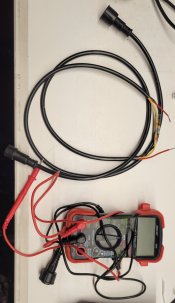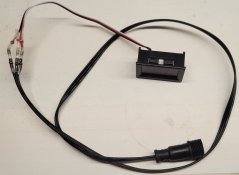Navigation
Install the app
How to install the app on iOS
Follow along with the video below to see how to install our site as a web app on your home screen.
Note: This feature may not be available in some browsers.
More options
You are using an out of date browser. It may not display this or other websites correctly.
You should upgrade or use an alternative browser.
You should upgrade or use an alternative browser.
Falcon F16v4
- Thread starter Gerald
- Start date
I'd daisy-chain the controllers unless they are in locations that make it more practical to add a switch and branch out from there.
Ultimately the Falcon has a 3 port switch inbuilt. Two accessible ports, and the third going to the processor in the Falcon. Functionally they are equivalent.
But, do keep in mind that the port are only 100Mbps on the Falcon, so don't use it where gigabit is required (Colorlight for example)
But, do keep in mind that the port are only 100Mbps on the Falcon, so don't use it where gigabit is required (Colorlight for example)
Gerald
Apprentice elf
- Joined
- Jan 5, 2022
- Messages
- 54
- Thread starter
- #5
So . I have installed the falcon and connected as discussed, On looking at it it reports a IP of 192.168.1.167 and entering that I get to the falcon page setup
The FPP page is showing 192.168.1.166 which presumably is coming from the Pi
Question is do I need to make both of these static IP,s in my router set up or change one of them in their own set up pages?
The FPP page is showing 192.168.1.166 which presumably is coming from the Pi
Question is do I need to make both of these static IP,s in my router set up or change one of them in their own set up pages?
I make all my IPs static because I want to keep what's left of my sanity.... it's all on its own network anyway. The "101" manual covers this... page number 90 (96th page of the .pdf).
There's more than one way to make them static, I suppose. I have the whole lights network running on its own unmanaged ethernet switches, so I just set the static IPs to 192.168.25.x (192.168 is common for private networks, 25 is easy to remember because of the 25th). Then the machine that connects to that network has a 192.168.25.x/24 routing rule for that network, so it doesn't get confused about what goes there vs to the home network router.
There are many other ways to do it, such as:
1. Teaching a router to give the devices the same info each time, by DHCP
2. Using one network, but giving the devices static IPs that the router would never give anything else.
3. More, I'm sure.
Part of the reason I did it the way I did is that the lights really should be on a 100% 100Mbps network, because some of the devices have 100Mbps ports, and they get a lot of UDP packets with the protocols I run, and any transition from 1Gbps -> 100Mbps risks dropping packets if the forwarding buffer is not big enough. So a separate network is a good, simple solution for network traffic engineering also.
There are many other ways to do it, such as:
1. Teaching a router to give the devices the same info each time, by DHCP
2. Using one network, but giving the devices static IPs that the router would never give anything else.
3. More, I'm sure.
Part of the reason I did it the way I did is that the lights really should be on a 100% 100Mbps network, because some of the devices have 100Mbps ports, and they get a lot of UDP packets with the protocols I run, and any transition from 1Gbps -> 100Mbps risks dropping packets if the forwarding buffer is not big enough. So a separate network is a good, simple solution for network traffic engineering also.
Gerald
Apprentice elf
- Joined
- Jan 5, 2022
- Messages
- 54
- Thread starter
- #9
I have sorted this one (I think)
Separate question before testing the contoller, as per the screenshot I have 2 props, trees and stars totaling 400 pixels with an x lights total of 8.8Amps
As they are all on port 1 (which I assume is 5 Amps total ) will this be OK? and not damage the controller, I can obviously power inject if needed for the lights but I wanted to make sure of the answer to this one as I seem to be going round in circles with answers on various web sites
Also how do you guys power inject with 2 separate supplies , I understand the theory with keeping a common ground and data chain but do you just cut the +feed from one before connecting to the other power supply
I do have some BALS tee pieces 3-3-2 but the power wire in these are all connected , do I open up the incomming lead and cut the + wire and then re insulate?
Separate question before testing the contoller, as per the screenshot I have 2 props, trees and stars totaling 400 pixels with an x lights total of 8.8Amps
As they are all on port 1 (which I assume is 5 Amps total ) will this be OK? and not damage the controller, I can obviously power inject if needed for the lights but I wanted to make sure of the answer to this one as I seem to be going round in circles with answers on various web sites
Also how do you guys power inject with 2 separate supplies , I understand the theory with keeping a common ground and data chain but do you just cut the +feed from one before connecting to the other power supply
I do have some BALS tee pieces 3-3-2 but the power wire in these are all connected , do I open up the incomming lead and cut the + wire and then re insulate?
Yes, the diagram for power injection is on page 47 of the 101 manual.
You may have other preferences, but I tend to use spare controller ports in the rare instances where I inject, use 3-3-3 tees, and just rip out the data pin I don't need. You can do this with needle nose pliers. Pinch+twist+pull hard. You could do this to the power pin too, I suppose.
There are reasons why the arguments go around in circles, and it has to do with theory vs practical details. In theory, a bunch of pixels will add up to a bunch of amps and blow a fuse; this means the safe thing is to limit the number of pixels to the max amps they could possibly draw. But in every configuration I've tested, as you add pixels they have more and more wire, more and more resistance to the far ones, and the voltage drops, and they can't pull current at low voltage, so they fade out. Strings of modern, 12V, wimpier resistor pixels at 4" spacing never seem to pull more than 4A, no matter how many you put in the string... they'll dim out first. You won't see 400 at full white on one port, but you can actually run them.
The problem with connecting the power and ground of two power supplies together also has to do with weird circumstances. In the steady state, if they're both powered ON, and there's a good load and a lot of resistance between them, there won't be any trouble. Current will just run from both of them toward the lower voltage region in the middle. If you're going to have a problem, it's going to be when one of the supplies is off and the other one is on, because one will try to push current into the other. If there's a lot of resistance in between, this may not really matter to your power supply. Then again, it might, which is why the safe thing is to not connect V+ together.
I say just try it. Blowing a fuse and replacing it is something you might as well get used to so you're not afraid of it and will be better at it if it happens in the field when you're under pressure. Same thing with a power supply, for that matter.
You may have other preferences, but I tend to use spare controller ports in the rare instances where I inject, use 3-3-3 tees, and just rip out the data pin I don't need. You can do this with needle nose pliers. Pinch+twist+pull hard. You could do this to the power pin too, I suppose.
There are reasons why the arguments go around in circles, and it has to do with theory vs practical details. In theory, a bunch of pixels will add up to a bunch of amps and blow a fuse; this means the safe thing is to limit the number of pixels to the max amps they could possibly draw. But in every configuration I've tested, as you add pixels they have more and more wire, more and more resistance to the far ones, and the voltage drops, and they can't pull current at low voltage, so they fade out. Strings of modern, 12V, wimpier resistor pixels at 4" spacing never seem to pull more than 4A, no matter how many you put in the string... they'll dim out first. You won't see 400 at full white on one port, but you can actually run them.
The problem with connecting the power and ground of two power supplies together also has to do with weird circumstances. In the steady state, if they're both powered ON, and there's a good load and a lot of resistance between them, there won't be any trouble. Current will just run from both of them toward the lower voltage region in the middle. If you're going to have a problem, it's going to be when one of the supplies is off and the other one is on, because one will try to push current into the other. If there's a lot of resistance in between, this may not really matter to your power supply. Then again, it might, which is why the safe thing is to not connect V+ together.
I say just try it. Blowing a fuse and replacing it is something you might as well get used to so you're not afraid of it and will be better at it if it happens in the field when you're under pressure. Same thing with a power supply, for that matter.
Well bad luck for you that the more-qualified Australians and New Zealanders are asleep at this hour and I'm in boring virtual work meetings.
Anyway, the power goes straight from the power supply to terminals on the controller board, then through large traces on the board, and a fuse, to the green connector, to the pigtail, to the pixels. So the only thing that should be damaged on over current is the fuse. If you manage to damage anything else, I'd go to the manufacturer under warranty.
Like I said, I never got a fuse to blow by just adding pixels (don't ask how I did do it). 12V regulators on full white very close to the controller do get right up to 5A (which may or may not be close to blowing a 5A fuse, see
View: https://www.youtube.com/watch?v=AUbmq6UJXgg
). How do I know? Well, this isn't exactly high precision, but I repurposed some pigtails and a cheap multimeter as pictured, to get a rough idea of the amps. Just put the 10A current setting to the red wires to complete the circuit. (Of course this is a crude method, because multimeter is slow and imprecise, the extra 3' of wire adds resistance, etc., but it is better than no data at all.)

Another thing that is quite handy is little volt meter soldered on a pigtail. Of course by "really handy" I mean you absolutely don't need one, unless you are curious, or are trying quick methods to diagnose problems that you shouldn't have if you're conservative.

Anyway, the power goes straight from the power supply to terminals on the controller board, then through large traces on the board, and a fuse, to the green connector, to the pigtail, to the pixels. So the only thing that should be damaged on over current is the fuse. If you manage to damage anything else, I'd go to the manufacturer under warranty.
Like I said, I never got a fuse to blow by just adding pixels (don't ask how I did do it). 12V regulators on full white very close to the controller do get right up to 5A (which may or may not be close to blowing a 5A fuse, see
View: https://www.youtube.com/watch?v=AUbmq6UJXgg
). How do I know? Well, this isn't exactly high precision, but I repurposed some pigtails and a cheap multimeter as pictured, to get a rough idea of the amps. Just put the 10A current setting to the red wires to complete the circuit. (Of course this is a crude method, because multimeter is slow and imprecise, the extra 3' of wire adds resistance, etc., but it is better than no data at all.)

Another thing that is quite handy is little volt meter soldered on a pigtail. Of course by "really handy" I mean you absolutely don't need one, unless you are curious, or are trying quick methods to diagnose problems that you shouldn't have if you're conservative.


